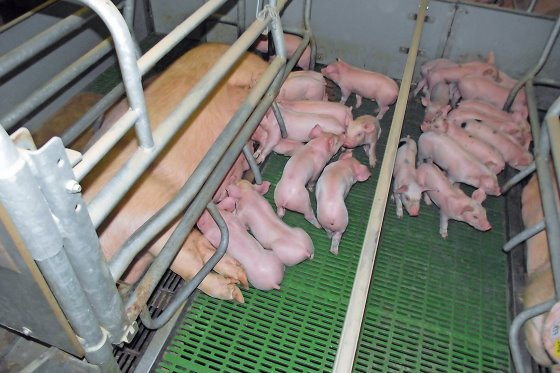上一篇文章中,我们讲述了世界各地仔猪断奶年龄的趋势,以及欧盟对断奶年龄的立法规定。
本篇将关注仔猪断奶对猪场效益的影响,以及通过对欧洲猪场的研究,断奶年龄与抗生素使用量是否存在联系?
Influence of weaning on farm results
断奶对猪场生产效果的影响
At weaning, two big changes occur for piglets: a change of diet and weaning stress.
断奶时,仔猪会经历两大变化:饮食更换和断奶应激。
Normally, a pig of a sow having a conventional milk production will only drink milk in the first 13-15 days of its life and not consume a lot of feed. Should weaning move to three weeks, then piglets only have one week to get used to the transition, whereas especially a normal pig is increasing its feed intake between three and four weeks of age. In addition, older pigs can more efficiently absorb nutrients as their gastro-intestinal tract is more mature.
正常情况下,一头常规产奶母猪的仔猪只会在生命前13-15天喝母乳,不会吃很多饲料。如果断奶时间延长到三周,那么仔猪只有一周的时间来适应这一过渡,而正常仔猪在三到四周大的时候会增加饲料的摄入量。此外,随着年龄的增长,猪的胃肠道更加成熟,能更有效地吸收营养。
Weaning stress comes into existence as many things change. Think of:
• Loss of maternal protection as sow milk-derived antibodies will be absent;
• Change of environment;
• Mixing of litters;
• Change of diet and consumption behaviour.
断奶应激是随着许多事情的变化而产生的。比如:
•没有了母源抗体,缺少母体保护;
•环境变化;
•混群;
•饮食习惯改变。

At weaning, two major changes can be observed: dietary changes as well as weaning stress.
Photo: Dr Merel Postma
断奶时,可以观察到两个主要变化:饮食改变和断奶应激。
图:Merel Postma博士
Back in 2009, the Spanish swine consultant José Barceló stated that piglets weaned at three weeks will be more vocal (e.g. by ‘crying’) after weaning (3.6 times per minute) compared to piglets weaned at four weeks (2.3-2.9 times per minute). In a study comparing weaning at four and seven weeks respectively, the stress hormone cortisol was lower at weaning at seven weeks when compared to four weeks. In addition, earlier-weaned piglets will display unpleasant behaviour like tail biting, ear sucking, breaking out, pushing, biting and nose thumping.
早在2009年,西班牙养猪顾问Jose Barcelo就指出,在断奶后,三周龄断奶的仔猪(每分钟3.6次) 与四周龄断奶的仔猪(每分钟2.3-2.9次)相比,会发出更多声音(例如“哭泣”)。在一项分别比较4周龄断奶和7周龄断奶的研究中,在断奶7周时,压力荷尔蒙皮质醇水平比断奶4周时的要低。此外,早期断奶仔猪还会出现咬尾、吮耳、破壳、推搡、啃咬和撞击鼻子等行为。
Piglets weaned at an older age will be heavier as well. These animals will often have a more efficient growth and lower mortality figures. At a too young weaning age, however, a growth check can be the result around weaning. That effect can continue into the finisher phase, where a worse growth in virtually the entire pig life can be observed. José Barceló, in 2009, even stated that for optimal performance in the finisher phase, a piglet should have an average weight of 7.5-8 kg, of which less than 10% of the animals should weigh less than 6 kg. A figure which is virtually impossible to achieve with weaning at 21 days. It is, however, possible with weaning at 28 days.
较晚断奶的仔猪也会更重。而且通常生长率更高、死亡率更低。而断奶年龄太小,生长抑制可能发生在断奶前后。这种影响可以持续到育肥阶段,在这个阶段,几乎可以观察到整个猪的生长都在恶化。Jose Barcelo在2009年甚至指出,为了在育肥阶段达到最佳性能,仔猪的平均体重应该在7.5-8公斤之间,其中,体重在6公斤以下的仔猪不应超过10%。这个数字在21天时断奶几乎是不可能达到的。然而,在28天断奶则有可能实现。
With regard to sow performance results, weaning later also provides an advantage in relation to the next litter. José Barceló stated that with Spanish data, an economic improvement of € 6 per pig can be achieved, should there be weaning at 28 days instead of at 21 days.
就母猪性能结果而言,晚断奶与下一窝相比也具有优势。Jose Barcelo表示,根据西班牙的数据,如果断奶时间从21天延长到28天,那么每头猪的经济效益可以增加6欧元。
Weaning age and antibiotic use
断奶年龄和抗生素的使用
In the study mentioned earlier, comparing pig farms in Belgium, France, Germany and Sweden, there was also attention paid to antibiotic usage on the total phase from birth to slaughter. Farms weaning at a younger age, often used more antibiotics between birth to slaughter. The idea behind that is – once more – that with weaning at a higher age the piglet will be more robust and more resilient. The animal will therefore be less susceptible for pathogens, resulting in lower need for antibiotics. In Scandinavia, often the weaning age is higher and these countries happen to be the most modest users of antibiotics in Europe.
在前面提到的研究中,对比了比利时、法国、德国和瑞典的养猪场,也关注了从仔猪出生到屠宰的整个阶段抗生素的使用情况。在较早断奶的猪场,抗生素的使用量通常更多。这再一次说明,断奶年龄越大,小猪长得更强壮、恢复力更强。也因此,这些仔猪对病原体的敏感性会降低,从而降低对抗生素的需求。在斯堪的纳维亚半岛,仔猪的断奶年龄通常较高,而这些国家正是使用抗生素最适度的欧洲国家。
In a very recent project in Flanders, Belgium, in total 16 farms focused on reducing antibiotic usage for a time frame of roughly nine months. Seven of these farms managed to send the majority of their pigs to the slaughterhouse completely without the usage of antibiotics – from birth to slaughter. Remarkable: on average these seven farms had a weaning age of 26 days – compared to an average weaning age of 23 days of those nine farms that ‘only’ managed to reduce antibiotics usage. More proof that weaning age and antibiotics usage are correlated.
在比利时弗兰德斯最近的一个项目中,总共有16个农场在大约9个月的时间内致力于减少抗生素的使用。其中,7个猪场成功实现大部分猪从出生到出栏,完全不使用抗生素。值得注意的是:这7个猪场的平均断奶年龄为26天,而另外9个“仅仅”成功减少抗生素使用的猪农场,其平均断奶年龄为23天。越来越多证据表明,断奶年龄和抗生素的使用有关。
(文/爱猪网记者刘坤颖编译,爱猪网原创,转载请注明出处)










